RESEARCH
Community wells to mitigate the arsenic crisis in Bangladesh
L'utilisation des puits communautaires permet d'atténuer l'exposition à l'arsenic au Bangladesh
Pozos comunitarios para mitigar la crisis del arsénico en Bangladesh
Alexander van GeenI,1; K.M. AhmedII; A. A. SeddiqueII; M. ShamsudduhaII
ILamont-Doherty Earth Observatory of Columbia University, Palisades, New York 10964, USA (email: avangeen@ldeo.columbia.edu)
IIGeology Department, Dhaka University, Dhaka, Bangladesh
ABSTRACT
OBJECTIVE: To monitor the effectiveness of deep community wells in reducing exposure to elevated levels of arsenic in ground-water pumped from shallower aquifers.
METHODS: Six community wells ranging in depth from 60 m to 140 m were installed in villages where very few of the wells already present produced safe water. By means of flow meters and interviews with villagers carrying water from the community wells, a study was made of the extent to which these were used during one year. The results were compared with household and well data obtained during a previous survey in the same area.
FINDINGS: The mean arsenic concentration in water pumped from wells already in use in the villages where the community wells, were installed was 180 ± 140 µg/l (n = 956). Monthly sampling for 411 months showed that arsenic levels in groundwater from five of the six newly installed wells were consistently within the WHO guideline value of 10 µg/l for drinking-water. One of these wells met the Bangladesh standard of 50 µg/l arsenic but failed to meet the WHO guideline values for manganese and uranium in drinking-water. The community wells were very popular. Many women walked hundreds of metres each day to fetch water from them. On average, 2200 litres were hand-pumped daily from each community well, regardless of the season.
CONCLUSION: A single community well can meet the needs of some 500 people residing within a radius of 150 m of it in a densely populated village. Properly monitored community wells should become more prominent in campaigns to reduce arsenic exposure in Bangladesh. Between 8000 and 10 000 deep community wells are needed to provide safe water for the four to five million people living in the most severely affected parts of the country.
Keywords: Potable water/analysis/standards; Arsenic; Water supply/standards; Bangladesh (source: MeSH, NLM).
RÉSUMÉ
OBJECTIF: Contrôler l'efficacité des puits communautaires profonds dans la diminution de l'exposition à l'arsenic présent à concentration élevée dans les eaux souterraines pompées dans les nappes phréatiques superficielles.
MÉTHODES: Six puits communautaires d'une profondeur de 60 à 140 mètres ont été installés dans des villages où les puits existants donnant de l'eau potable étaient très peu nombreux. Une étude basée sur l'interrogation des villageois transportant l'eau de ces puits communautaires et sur les relevés des débitmètres a permis d'évaluer l'utilisation de ces puits au cours d'une année. Les résultats ont été comparés à ceux d'une enquête antérieure menée dans la même zone utilisant les données recueillies auprès des ménages et celles fournies par les puits.
RÉSULTATS: La concentration moyenne en arsenic dans l'eau pompée à partir des puits déjà utilisés dans les villages où les puits communautaires ont été installés atteignait 180±140 µg/l (n = 956). L'échantillonnage mensuel pendant 4 à 11 mois a montré que la concentration en arsenic des eaux souterraines issues de cinq des six puits nouvellement installés était constamment situé à l'intérieur des valeurs guides de l'OMS, à savoir 10 µg/l pour l'eau de boisson. L'eau de l'un de ces puits était conforme aux normes du Bangladesh, soit 50 µg/l d'arsenic, mais non conforme aux valeurs guides OMS concernant la concentration du manganèse et de l'uranium dans l'eau de boisson. Les puits communautaires ont été très appréciés et nombreuses étaient les femmes marchant plusieurs centaines de mètres chaque jour pour y puiser de l'eau. En moyenne, 2200 litres d'eau ont été pompés à la main chaque jour à partir de chacun des puits communautaires, quelle que soit la saison.
CONCLUSION: Un puit communautaire répond aux besoins d'environ 500 personnes résidant dans un rayon de 150 mètres dans un village densément peuplé. Bien contrôlés, les puits communautaires devraient prendre une importance croissante dans les campagnes visant à réduire l'exposition à l'arsenic au Bangladesh. De 8000 à 10 000 puits communautaires profonds sont nécessaires pour fournir de l'eau potable aux 4 à 5 millions de personnes qui habitent les régions les plus touchées du pays.
Mots clés: Eau potable/analyse/normes; Arsenic; Alimentation eau/normes; Bangladesh (source: MeSH, INSERM).
RESUMEN
OBJETIVO: Vigilar la eficacia de los pozos profundos comunitarios como alternativa para reducir la exposición a los niveles elevados de arsénico presentes en el agua subterránea bombeada desde acuíferos más superficiales.
MÉTODOS: Se abrieron seis pozos comunitarios con una profundidad de entre 60 y 140 metros en aldeas en las que muy pocos de los pozos ya existentes contenían agua potable. Utilizando caudalímetros y entrevistando a los aldeanos que transportaban el agua de los pozos de la comunidad, se llevó a cabo un estudio del uso que se hacía de ellos a lo largo de un año. Los resultados se compararon con los datos que sobre los hogares y los pozos se habían obtenido en una encuesta anterior en la misma zona.
RESULTADOS: La concentración media de arsénico en el agua bombeada de los pozos ya utilizados en las aldeas donde se instalaron los pozos comunitarios fue de 180 ± 140 µg/l (n = 956). Las muestras mensuales de 4-11 meses mostraron sistemáticamente que las concentraciones de arsénico en el agua subterránea de cinco de los seis nuevos pozos se mantenían por debajo del valor de 10 µg/l estipulado por la OMS para el agua potable. Uno de estos pozos satisfacía la norma de 50 µg/l de arsénico establecida en Bangladesh, pero no así las normas de la OMS en lo tocante al manganeso y el uranio en el agua potable. Los pozos comunitarios fueron muy apreciados. Muchas mujeres caminaban cientos de metros cada día para sacar agua de ellos, y por término medio se bombeaban a mano diariamente 2200 litros en cada uno, independientemente de la estación.
CONCLUSIÓN: Un solo pozo comunitario basta para cubrir las necesidades de unas 500 personas residentes en un radio de 150 metros en una aldea densamente poblada. Controlados debidamente, los pozos comunitarios deberían tener un papel más destacado en las campañas destinadas a reducir la exposición al arsénico en Bangladesh. Se requieren entre 8000 y 10 000 pozos profundos comunitarios para abastecer de agua potable a los cuatro o cinco millones de personas que viven en las zonas más gravemente afectadas del país.
Palabras clave: Agua potable/análisis/normas; Arsénico; Abastecimiento de agua/normas; Bangladesh (fuente: DeCS, BIREME).
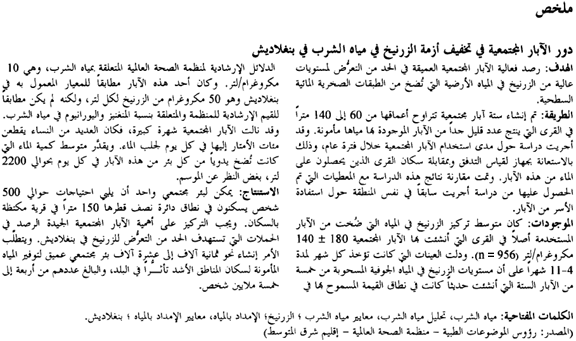
Introduction
Groundwater is a popular source of microbially uncontaminated drinking-water throughout the lowlands of South Asia. In Bangladesh there are approximately 10 million hand-pumped tube wells (1, 2). A tube well near a house is a convenient source of water and its cost of about US$ 50 is moderate in relation to household income in a country with a per capita gross national product (GNP) of US$ 400 (3). However, elevated arsenic levels in groundwater pumped from approximately one-third of the tube wells in Bangladesh and from an unknown proportion of wells in other South Asian countries are likely to cause numerous cancers of the skin, liver, lungs and other internal organs over the next several decades (46).
Despite their limitations (7), testing campaigns involving the use of field kits have been useful in identifying areas of Bangladesh where over 80% of the wells contain elevated arsenic levels (Fig. 1). The sharing of wells in which arsenic levels are low as indicated by field tests is not practicable for the four to five million people living in these areas because, typically, the nearest safe wells are beyond walking distance (2). However, the installation of properly monitored community wells intended for use by all persons in the villages concerned offers a promising solution. Six such wells were installed on private land in several villages where there had been very few safe wells, and their usage was tracked for over a year. This information was compared with the results of a detailed survey of wells and households in the same area (2, 8).
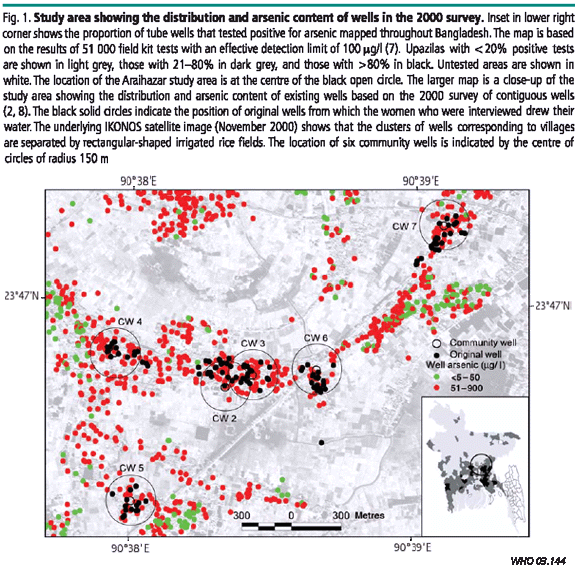
Methods
Six community wells were installed in an area of 6 km2 within Araihazar upazila, one of 490 similar administrative units in Bangladesh. The arsenic content of groundwater pumped from 956 previously surveyed wells in the area averaged 180 ± 140 µg/l and only 20% of the wells met the Bangladesh standard of 50 µg/l for arsenic in drinking-water. The term "unsafe" as used below refers to arsenic concentrations above this level whereas the WHO guideline value for arsenic is 10 µg/l. Fig. 1 shows the locations of the largely private wells that were already present in the villages, their arsenic levels, the locations of the new community wells, and the main roads in the study area. An appropriate site for the construction of each community well was determined after a local resident agreed to provide a readily accessible parcel of land for this purpose. In March 2003, local residents indicated that owners were continuing to give unconditional access to the community wells installed on their land.
In January 2001 the first community well (CW2) was sunk to a depth of 90 m by means of a large bamboo rig and a Dunkin pump. This technology is not readily available locally and not typically used to install private wells in the area. An initial target depth of 60 m for five additional community wells was decided on for the following reasons:
an earlier survey of 6000 wells in the region (8) and the monitoring of a nest of wells installed next to CW2 in January 2001 suggested that groundwater arsenic levels were likely to be below 50 µg/l at that depth;
a depth of 60 m is readily reached in one day by local drilling teams using a small bamboo rig, connected sections of PVC pipe, and the sludger or hand-flapper method.
This depth proved satisfactory for community wells CW3, CW4 and CW6, which were sunk in June 2001. A drilling team with a Dunkin pump had to reinstall community wells CW5 and CW7 in September 2001 to depths of 120 m and 140 m, respectively, in order to reach an aquifer with a sufficiently low arsenic concentration.
Groundwater was collected without filtration from the community wells approximately once a month in acid-cleaned 60-ml polyethylene bottles and acidified in the field with 1% hydrochloric acid. The time-series samples were analysed for arsenic by high-resolution inductively coupled plasmamass spectrometry (HR ICPMS) with a detection limit of 0.1 µg/l (9). HR ICPMS was also used to measure the concentrations of an additional suite of inorganic constituents for which there are WHO guideline values for drinking-water (9).
In January 2002, between four and eleven months after installation, the amount of water hand-pumped by the villagers during the dry season (November to May) was measured over 24 hours by means of a flow meter on the spout of each of the six pumps. The meters reduced the flow rate from 2035 l/min to 9 l/min. In order to determine usage during the wet season (June to October) the same flow meters were used for 24 hours in August 2002.
During the dry and wet seasons, 167 villagers, nearly all women who were pumping water from community wells were interviewed and accompanied to their homes. They were asked to indicate the tube wells that they had previously used. Some of these wells had been used by more than one of the interviewees. The positions of the 103 wells were recorded with a hand-held Global Positioning System (GPS) receiver. At 90 of the wells, a metal tag showing whether the arsenic content of the water was safe or unsafe had been posted in November or December 2001. This was done in conjunction with an extensive campaign on the health risks of arsenic, whereby information was provided at village meetings through storytelling and the status of each well was notified to individual households. Four of the remaining thirteen wells had been tested but their tags had been removed, and nine had not been tested previously, either because they had been overlooked during the 2000 survey or because they had been installed subsequently.
Results
In groundwater pumped from five of the six community wells, arsenic concentrations were consistently below the WHO guideline of 10 µg/l (Table 1). There were small but consistent declines in arsenic concentrations during the first two months after installation (data not shown). Since the decline in arsenic concentrations paralleled a reduction in the iron content of these unfiltered samples, it was attributed to an increase in the effectiveness of the trapping of fine aquifer particles by the slotted filters installed at the bottoms of the wells. As previously reported for other wells in the same area (2), there were no noticeable seasonal variations in arsenic concentrations. In CW4 the arsenic concentrations were significantly higher than in the other wells (Table 1) but met the Bangladesh standard of 50 µg/l except in one sample whose elevated iron content suggested that arsenic was released from particles pumped with the water after the sample was acidified. Even CW4, however, provided water with less dissolved arsenic than any of the surrounding wells. The villagers were informed of the results of these analyses soon after installation and advised to use water from the community wells for drinking and cooking. The continued use of all the previously installed private wells was encouraged for washing and personal hygiene.
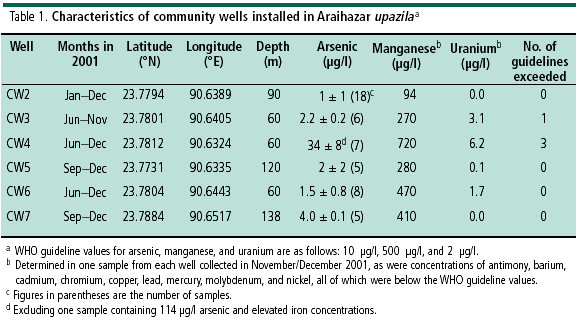
Further analysis by HR ICPMS showed that CW4 also exceeded the WHO guidelines for manganese and uranium in drinking-water by factors of 1.4 and 3.1, respectively (Table 1). Groundwater pumped from CW3 slightly exceeded the guideline value for uranium. Steady concentrations of manganese and uranium were attained after a few months of usage, indicating that these constituents were primarily dissolved in groundwater. In all the community wells the concentrations of antimony, barium, cadmium, chromium, copper, lead, mercury, molybdenum, and nickel measured by HR ICPMS were much below the WHO guideline values. In the dry season the volume of water pumped from the community wells lay in the range of 12002600 l/day (Table 2). In the following wet season the corresponding range was 13003900 l/day. For all these wells and both seasons the average amount of water pumped by hand was 2200 l/day. All the interviewed villagers indicated that they took water from the community wells because of an awareness that arsenic presented a health hazard. A few women said that additional reasons for preferring water from these wells were that it tasted better and did not contain a brown, i.e. iron, precipitate. Only at CW3 and CW4 did a significant number of women indicate that they did not have to queue before pumping water. This was consistent with the flow readings, the lowest of which corresponded to these wells (Table 2).
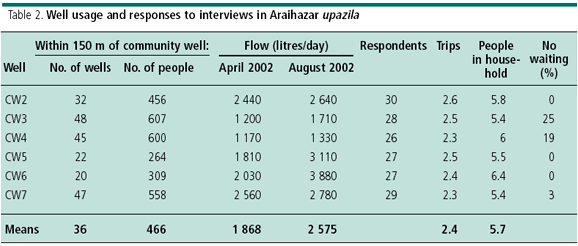
We used GPS data to show that the interviewed women travelled considerable distances in order to fetch water. The accuracy of the GPS data was first assessed by comparing the positions of the 103 previously used wells determined in 2002 to the positions determined during the initial survey of the area in 2000. Some of these positions were determined before the degradation of the GPS signal on 1 May 2000. Since the wells were not moved, the distance between the two positions in each case provides an indication of the uncertainty of the GPS readings. Excluding five positions that were clearly entered incorrectly in 2000 or 2002, the distances between the original and new positions averaged 37 ± 27 m. Of the original GPS positions, 97% were within 100 m of the second measurement (Fig. 2(a)).

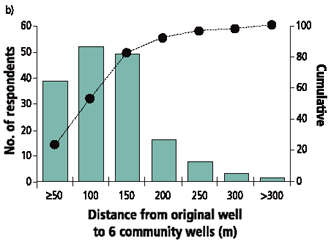
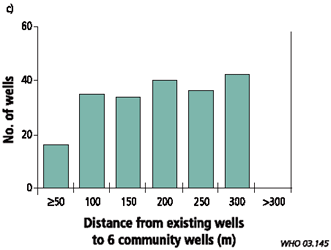
The distances between previously used wells and the corresponding community wells were considerably larger than the estimated uncertainty for repeated GPS measurements (Fig. 2(b)). The locations of the older wells provided an appropriate starting point because they were near the houses of the interviewed women, 40% of whom indicated that they owned the original wells. When fetching water from community wells, 140 of the interviewed women (84%) regularly walked up to 150 m each way. As many as 27 of the interviewed women walked greater distances in order to obtain water from these wells. The number of users residing more than 150 m from a community well was too large to be attributed to measurement error (Fig. 2(b)). A single outlier, 440 m south of CW6, could not be discounted for any other reason than that the purported location of this well, whose tag was removed, was in the middle of a field (Fig. 1).
Discussion
Sediment cuttings collected during drilling indicated that CW3, CW5, CW6 and CW7 tapped into the orange Dupi Tila sands deposited before a rise in sea level of about 100 m led to the formation of the Ganges-Brahmaputra-Meghna Delta over the past 12 000 years (8). Cuttings collected at 60 m during the first attempt to sink wells at the sites of CW5 and CW7, and cuttings from 90 m at CW2, were grey and had probably been deposited more recently. The association between groundwater arsenic and sediment colour has been noted previously and confirms that, while groundwater meeting the Bangladesh standard of 50 µg/l arsenic can occasionally be extracted from grey sand, water meeting the WHO guideline of 10 µg/l is more consistently found in the orange Dupi Tila sands (1, 8). The range of 60150 m in the depth of this formation for four wells located within 1.3 km of each other illustrates the difficulty of predicting the locations of aquifers with low arsenic concentrations.
Clearly, it would have been preferable for the community wells to meet all the WHO guideline values for drinking-water. Nevertheless, HR ICPMS analysis of groundwater from a subset of 630 of the 6000 wells that were already present in Araihazar provides a useful perspective. In the case of manganese, 84% of these wells, most of which were of shallow construction, exceeded the WHO guideline value of 500 µg/l, whereas only one of the six community wells did so (9). With regard to uranium, only 4% of the 630 original wells exceeded the guideline value of 2 µg/l, whereas two of the six community wells did so. However, this guideline value is much stricter than the current United States Environmental Protection Agency maximum contaminant level of 30 µg/l for uranium in drinking-water (10). We intend to install a deeper community well at the CW4 site in the near future.
In order to assess whether the responses of the 167 women interviewed at the community wells were representative of village opinion, a comparison was made between well usage and household data previously collected in the same area. The distances between all previously sunk wells and the community wells were calculated. On average, 36 older wells were within 150 m of a community well (Table 2). A comparison of the distances between all original wells and the community wells (Fig. 2(c)) with the distances between original wells to community wells reported by the 167 interviewed women (Fig. 2(b)) suggests that, on average, a constant proportion of the households located within 150 m of a community well took advantage of it.
The number of villagers using the original wells was reported in the household survey conducted in 2000 (2). Although the population living within 150 m of a community well varied widely, the average of about 500 was representative of a fairly densely populated village (Table 2). This information, together with the average well usage of 2200 l/day determined by means of flow meters, indicates that about 4 l were hand-pumped and carried back to each household on a daily basis for every person living within 150 m of a community well. This daily consumption, a slight overestimate since 16% of the interviewed women walked more than 150 m to fetch their water, is comparable to the per capita consumption of water for drinking and cooking in the region. Unless much of this water was used for other purposes such as washing, which seems unlikely in view of the effort required to fetch it, virtually every household within 150 m was evidently obtaining water for drinking and cooking from a community well.
An entirely independent estimate of daily consumption was obtained on the basis of additional information gathered during the interviews. The responses indicate that women made an average of 2.4 trips a day to their community wells (Table 2), using containers with capacities ranging from 15 l to 25 l. Since, on average, the women were fetching water for 5.7 household members, the average daily consumption of community well water per household member was 610 l (Table 2). Given the uncertainties and the possibility that the flow meters hampered usage, such reasonable agreement between these independent estimates is encouraging. The interview data confirm that essentially all households within 150 m of community wells switched to these as their main source of potable water. In comparison with the original average of 270 ± 110 µg/l, therefore, the construction of these wells led to a dramatic drop in the concentration of arsenic to which some 2800 people residing within a distance of 150 m were exposed.
The present study suggests that the installation of community wells would be of value in areas of Bangladesh where the proportion of safe wells is particularly low and the sharing of such wells is consequently not a viable option. By extrapolating our observations to the four to five million people living in areas where the proportion of wells containing high levels of arsenic is greater than 80% (Fig. 1), we estimate that 8 00010 000 community wells are needed in these areas. This is not a simple task, given the variability in the depth at which low-arsenic groundwater occurs and the depth limitation of the drilling technology that is locally available. The cost of drilling and the installation of a community well is approximately US$ 3 per metre, regardless of the technology employed. However, the main obstacles may relate to information and logistics, in the sense that the likely depth of a low-arsenic aquifer has to be determined by examining the geology of the site and conducting an arsenic and depth survey of wells already present in the village concerned. Once the depth of a safe aquifer has been confirmed by the installation of a community well, the households that can afford it are likely to have their own wells reinstalled to the same depth. This should eventually reduce the number of people who have to wait in queues to obtain water at community wells.
The targeting of safe deep aquifers for the installation of community wells appears to be a more promising option than that of treating high-arsenic groundwater or microbially contaminated surface water (7). Aquifers associated with older orange-brown sand deposits can be reached from almost any location in Bangladesh, although the shallowest depth of occurrence of such aquifers varies widely (1, 8). Although we know of no proper documentation of large increases in groundwater arsenic levels in Bangladesh, the possibility of such changes cannot be ruled out (1, 8). Careful monitoring of a subset of properly installed community wells throughout the country in the coming years is therefore necessary. The competing use of the deeper low-arsenic aquifers for irrigation, on the other hand, must be prevented.
Conclusion
Community wells offer a promising solution for villages where a large proportion of the wells already in use contain water with a high concentration of arsenic. A community well can provide enough water for about 500 people. In a densely populated village this is roughly the number of people residing within the distance of 150 m that women are willing to walk several times a day in order to fetch water for their families. Villagers in the study area were repeatedly encouraged to use community wells through our research activities. Community involvement in the installation, maintenance and monitoring of such wells is therefore crucial if comparable responses are to be obtained elsewhere. 
Acknowledgements
The work reported in this paper was supported by the US NIEHS/Superfund Basic Research Program (Grant P42ES10349). The household data were collected and provided by H. Ahsan and J. H. Graziano at the Mailman School of Public Health, Columbia University. We thank our colleagues and students Y. Zheng, M. Stute, H.J. Simpson, P. Schlosser, M. Steckler, R. Versteeg, I. Gavrieli, S. Goodbred, F. Parvez, A. Pfaff, M. Madajewicz, Z. Cheng, R.K. Dhar, A. Horneman, Z. Aziz and M.A. Hoque for their contributions at various stages of this work. This is LDEO contribution number 6460.
Conflicts of interest: none declared.
References
1. British Geological Survey and Department of Public Health Engineering. Arsenic contamination of groundwater in Bangladesh. In: Kinniburgh DG, Smedley PL, editors. BGS Technical Report WC/00/19 (Vol. 2, Final Report). Keyworth, England: British Geological Survey; 2001.
2. van Geen A, Ahsan H, Horneman A, Dhar RK, Zheng Y, Hussain AZMI, et al. Promotion of well-switching to mitigate the arsenic crisis in Bangladesh. Bulletin of the World Health Organization 2002;80:732-7.
3. World Bank. World development report 199899. New York: Oxford University Press; 1999.
4. Smith AH, Lingas EO, Rahman M. Contamination of drinking-water by arsenic in Bangladesh: a public health emergency. Bulletin of the World Health Organization 2000;78:1093-103.
5. World Health Organization. Guidelines for drinking-water quality. Health criteria and other supporting information (Volume 2, Second Edition). Geneva: World Health Organization; 1996. p. 940-9.
6. World Health Organization. Guidelines for drinking-water quality (Addendum to Volume 2, Second Edition). Geneva: World Health Organization; 1998. p. 281-3.
7. BRAC. Combating a deadly menace: Early experiences with a community-based arsenic mitigation project in Bangladesh. Dhaka: BRAC; 2000. Research Monograph Series, No. 16.
8. van Geen A, Zheng Y, Versteeg R, Stute M, Horneman A, Dhar R, et al. Spatial variability of arsenic in 6000 tube wells in a 25 km2 area of Bangladesh. Water Resources Research/2003;39:1140.
9. Cheng Z, Zheng Y, Mortlock R, van Geen A. Rapid multi-element analysis of groundwater by high-resolution inductively-coupled plasma mass spectrometry. Submitted to Environmental Science and Technology, May 2003.
10. Available from: URL: http://www.epa.gov/safewater/rads/radfr.pdf.
1 Correspondence should be addressed to this author.
